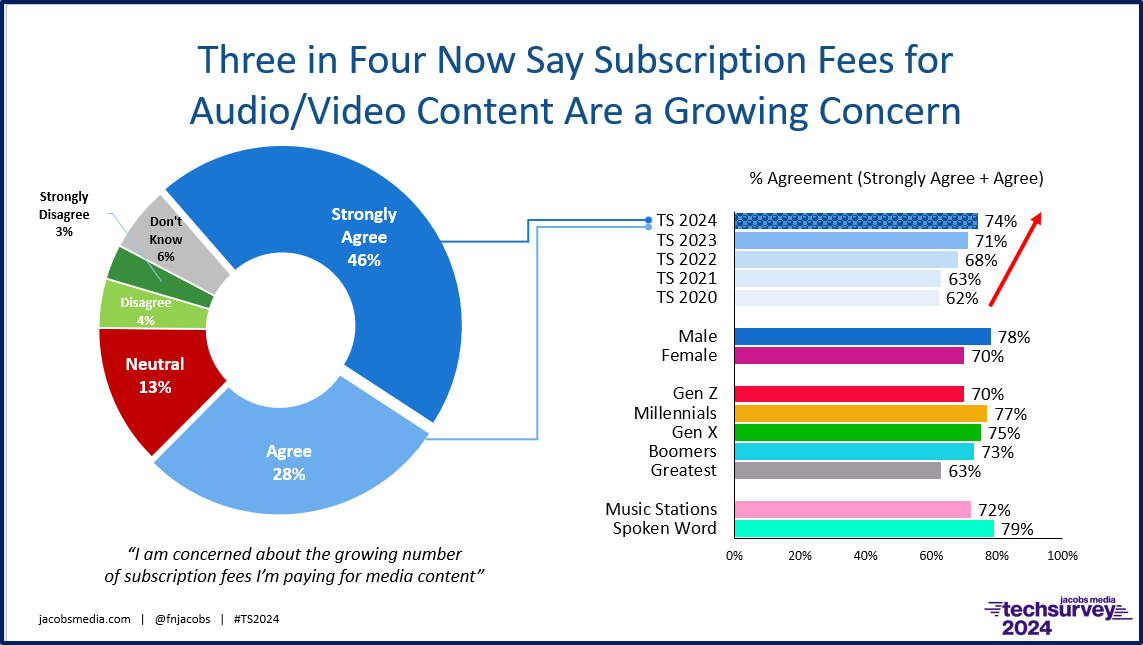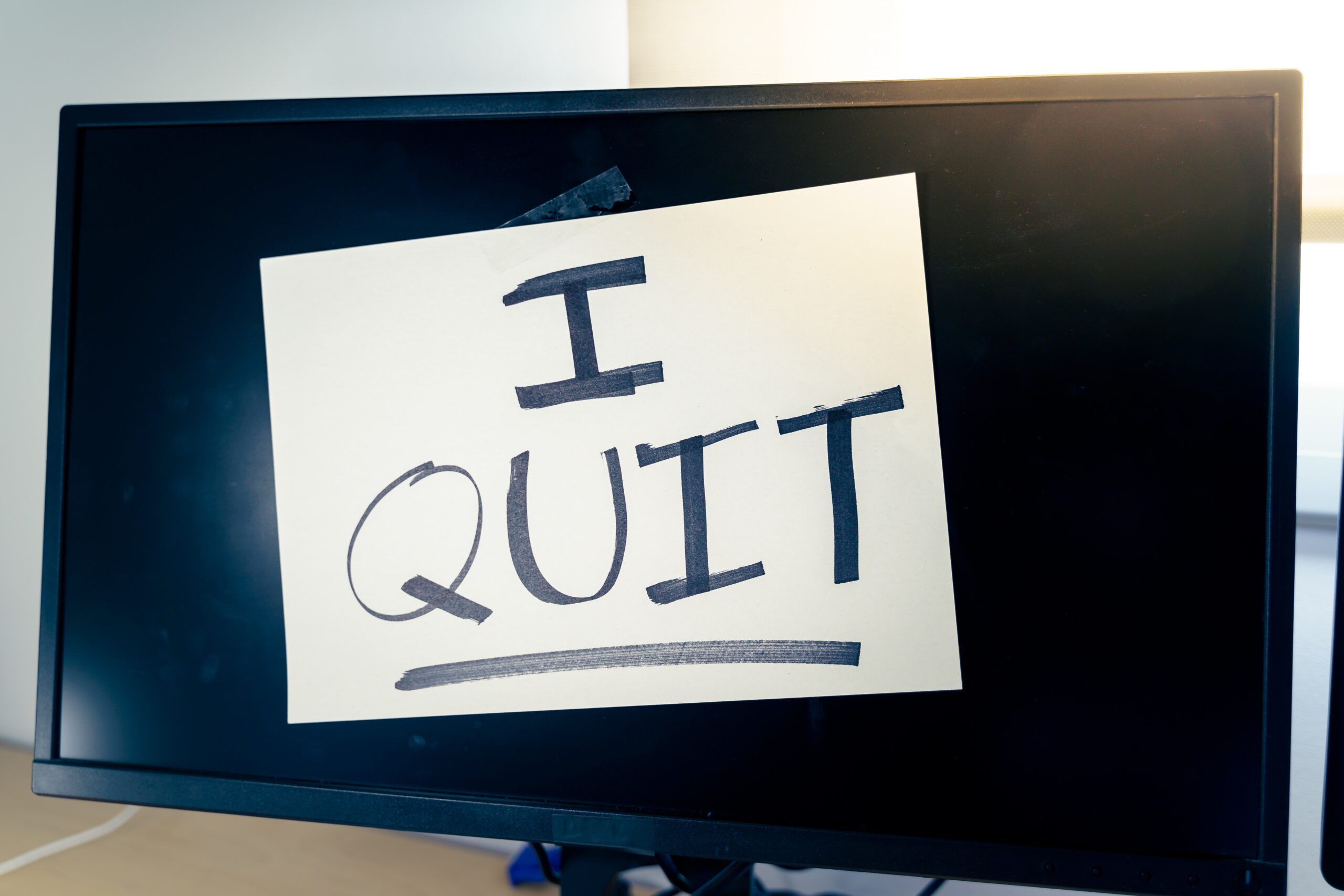
Did COVID turn us into a society of quitters?
Americans shy away from that label. After all, we celebrate workers everywhere each September on Labor Day. And we admire those who roll up their sleeves and pull themselves up by their bootstraps.
But something happened during the pandemic that seemed to impact our societal stick-to-it-tive-ness. That’s why it got quickly branded with the moniker, “The Great Resignation.” At its height in 2022, a record 4.5 million workers – approximately 3% of the U.S. workforce – quit their jobs.
And here we are two years later, and that mindset has very much become a part of our new fabric. CNBC reporting on a recent LinkedIn/Microsoft study indicates nearly half of professionals in the U.S. (46%) says they’re thinking about quitting their job.
(Why didn’t we invest in Indeed and Zip Recruiter?)
And my theory is that the “I Quit” mindset has now bled over to other activities in our lives. Maybe it was the utter bleakness and angst caused by the pandemic, but it seems like Americans are less likely to put up with anything that just doesn’t sit right. Rather than wait it out and perhaps give things time to settle in and adjust, our tendency is to now push the “escape” button and head for the exits.
It didn’t used to be this way. Back in 2023, TRG Datacenters reported the social media platform consumers were most motivated to delete was Instagram. Overall, roughly 13% of its user base were searching the internet to figure out the best way to delete their account. But when you’ve got 2 billion users from around the world, a certain attrition rate is to be expected.
Maybe that’s what Elon Musk calculated when he joined forces with Donald Trump. While there’s no argument about his gain in influence, especially since the election, Twitter – or X, as he’s rebranded it – very much became an arm of the Trump campaign, including a modification of the algorithm to ensure users regularly see Musk’s tweets.
So what did it cost X in subscribers?
According to PCMag, 115,000 left the platform after the election. (But on the other side, The Wrap reports that as of last week, X has gained back similar numbers of new acolytes.)
We’ve seen a lot of celebrity quits in recent week, including horror author Stephen King who declared X was “too toxic” for his sensibilities. In quitting the platform, King invited fans to “Follow me on Threads, if you like.”
Actually the big winner from all those “X quits” has been Bluesky, a social site that resembles the old Twitter (even setting a limit of 200 characters per post). In fact, Twitter founder and former CEO, Jack Dorsey, developed Bluesky back in 2019. According to a USA Today story last week, Bluesky now has 20 million users and continues to be on the upswing.

But perhaps the most salient message is just how fickle we consumers really are. After all, Threads experienced a meteoric rise when it first launched nearly 17 months ago, but its trajectory has been more like a Roman candle – a fast rise followed by a steady descent. (At least, Stephen King is using it.)
The phenomenon in play here may be that incumbent technologies and platforms, in particular, are vulnerable to our whims, especially if they’ve been around for a while. A story in Forbes by Brad Adgate points out how Google search is more than a quarter century old, while Facebook is almost of legal age – 20 to be exact. Not everyone is enamored by these legacy tech brands, opening the door to new search engines, like OpenAI, as well as social newcomers such as Bluesky.
Of course, calling it quits on subscription services isn’t new, but the rate of speed at which it’s happening fits right into this post’s main point: we think of nothing of giving any platform or service the boot if it isn’t satisfying us at the moment.
It turns out 2023 was a record year for cancelling a subscription, such as Spotify, Netflix, or the dozens of others that provide content for a monthly fee. We know from our Techsurveys that rising/aggregated fees on these services hit an all-time high this year, opening the door to the “cycle of quitting.”

The New York Times nailed the pattern in a story by John Koblin that ran this past April. In “Americans’ New TV Habit: Subscribe. Watch. Cancel. Repeat.,” he captures the sequence of events that regularly takes place as we chase the content we covet.
It turns out 29 million consumers – about one-fourth of streaming subscribers – have deep-sixed one of these services over the past two years.
Expect this pattern to accelerate as it becomes more apparent to sports fans their favorite games are now the possession of streaming services like Netflix, Amazon, Apple, Peacock, or others. Juggling subscription services has become a critical skill in the once sedentary art of simply watching TV.
 Not anymore. Thankfully, streaming services have made it easy, if not almost brainless, to execute – while we’re eating, standing in line at the grocery store, or waiting for our oil to be changed. Quitting is now a no-brainer.
Not anymore. Thankfully, streaming services have made it easy, if not almost brainless, to execute – while we’re eating, standing in line at the grocery store, or waiting for our oil to be changed. Quitting is now a no-brainer.
Once the totals are in, it would not be the least bit surprising if 2024 set the record for cancellations of these streaming services – further proof our media habits are changing. Koblin quotes Jonathan Carson, CEO of Antenna, who notes that “in three years, this went from a very niche behavior to an absolute mainstream part of the market.”
Everyone in the subscription business will be affected, including our friends at SiriusXM. They’ve turned roadblocks into quitting their service into an art form. If you’ve experienced the Kabuki dance that reliably takes place when you try to quit SiriusXM, you have a new understanding of what persistence is all about.
Similar to the rigmarole would-be buyers or lessors have to endure in new car showrooms, SXM phone operators (you have to talk to an actual human in order to terminate the service) are well-trained in systematically ratcheting down the price until the exhausted subscriber eventually gives in and agrees to a new contract. It’s archaic and annoying, but that’s the way they designed it at SXM. And they’ve gotten away with it.
Until now.
As reported in a Radio Ink story yesterday, New York Attorney General Letitia James (remember her?) sued SXM. The suit claimed the satellite radio company “illegally traps people into subscriptions” because of its long cancellation procedures. And New York Supreme Court Judge Lyle E. Frank ruled against SiriusXM last week.
While SXM claimed its subscribers use the cancellation calls as a way “to get a discount on their service,” complaints from consumers revealed SXM operators were instructed to use a six-part conversation that included as many as five different retention offers.
Judge Frank also noted that while it’s quick and easy to purchase a service plan from SXM, the average phone call to cancel lasts more than 11 minutes, while trying to cancel online requires 30 minutes on average.
 It turned out it’s easier for Howard Stern to cancel his Sirius contract when it expires than it is for any of us to do the same.
It turned out it’s easier for Howard Stern to cancel his Sirius contract when it expires than it is for any of us to do the same.
To emphasize the need for smoother cancellation, the Federal Trade Commission has a new rule going into effect in mid-January that requires companies like SXM, Netflix, and Spotify to make it as easy to get out of a subscription as it was to sign up in the first place.
With a new administration taking office just a few days later, it remains to be seen how media and entertainment services will be impacted. Just yesterday, Representative Marjorie Taylor Greene announced that as part of a new House subcommittee looking into “wasteful spending” will initially go after NPR. The story was covered in today’s Inside Radio.
As the song goes, “Quitters gonna quit.” Now governments are going to make it much easier and seamless to pull it off.
For broadcast radio, there’s good news here. AM/FM’s “no subscription fees” policy sets it apart from most of today’s media platforms and brands. Thus, no cancellations or subscription juggling involved. Your favorite station doesn’t send you a bill at the end of the month. Radio is FREE.
But the not-so-good news is that consumer fickleness and resistance to putting up with the least bit of friction or a bad experience has increased. When they get pissed off by a medium, channel, or station, their inclination is to get out and go elsewhere. There’s no need to leave a note or email of explanation.
A shorter leash puts even more pressure on over-the-air radio, already struggling with service cutbacks, job losses, and an overabundance of ads. In our research studies, we need to do better than just talk to those who stay with radio through thick and thin. The disillusioned, the angry, the ex-pats, and the quitters need to be accounted for, too.
Originally published by Jacobs Media









